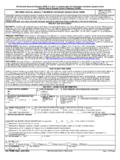Transcription of report of the fort hood independent ... - United States Army
1 NOVEMBER 6, 2020report of the fort hood independent review committeeReport of the Fort Hood independent Review Committee EXECUTIVE SUMMARY The U. S. Secretary of the army appointed the Fort Hood independent Review Committee (FHIRC or Committee) and directed it to conduct a comprehensive assessment of the Fort Hood command climate and culture [], and its impact, if any, on the safety, welfare and readiness of our Soldiers and units. In addressing this mandate, the FHIRC determined that during the time period covered by the Review, the command climate relative to the sexual Harassment/ assault Response and Prevention (SHARP) Program at Fort Hood was ineffective, to the extent that there was a permissive environment for sexual assault and sexual As set forth in this report , specific Findings demonstrate that the implementation of the SHARP Program was ineffective.
2 During the review period, no Commanding General or subordinate echelon commander chose to intervene proactively and mitigate known risks of high crime, sexual assault and sexual harassment. The result was a pervasive lack of confidence in the SHARP Program and an unacceptable lack of knowledge of core SHARP components regarding reporting and certain victim services. Under a structurally weak and under-resourced III Corps SHARP Program, the sexual assault Review Board (SARB) process was primarily utilized to address administrative and not the actual substantive aspects of the Program. While a powerful tool by design, the SARB process became a missed opportunity to develop and implement proactive strategies to create a respectful culture and prevent and reduce incidents of sexual assault and sexual harassment.
3 From the III Corps level and below, t he SHARP Program was chronically under-resourced, due to understaffing, lack of training, lack of credentialed SHARP professionals, and lack of funding. Most of all, it lacked command emphasis where it was needed the most: the enlisted ranks. A resonant symptom of the SHARP Program s ineffective implementation was significant underreporting of sexual harassment and sexual assault . Without intervention from the NCOs and officers entrusted with their health and safety, victims feared the inevitable consequences of reporting: ostracism, shunning and shaming, harsh treatment, and indelible damage to their career.
4 Many have left the army or plan to do so at the earliest opportunity. As part of the command climate, the issues of crime and Criminal Investigation Division (CID) operations were examined. The Committee determined that serious crime issues on and off Fort Hood were neither identified nor addressed. There was a conspicuous absence of an effective risk management approach to crime incident reduction and Soldier victimization. A military installation is essentially a large, gated community. The Commander of a military installation possesses a wide variety of options to proactively address and mitigate the spectrum of crime incidents.
5 Despite having the capability, very few tools were employed at Fort Hood to do so. Both the Directorate of Emergency Services (DES) and the CID have a mandate and a role to play in crime Each 1 Per an Agreement with the Undersecretary of the army , the review period encompassed Fiscal Years (FY) 2018, 2019, and 2020. Data and information from previous FYs were incorporated as necessary for context. 2 Relevant to crime prevention and investigations, two of CID s mandated objectives are: (i) Participating in the army crime prevention program by identifying areas which are especially vulnerable to crime and by making recommendations to appropriate report OF THE FORT HOOD independent REVIEW COMMITTEE report of the Fort Hood independent Review Committee Page iii of ix contributed very little analysis, feedback and general situational awareness to the command toward facilitating and enabling such actions.
6 This was another missed opportunity. The deficient climate also extended into the missing Soldier scenarios, where no one recognized the slippage in accountability procedures and unwillingness or lack of ability of non-commissioned officers (NCOs) to keep track of their subordinates. The absence of any formal protocols for Soldiers who fail to report resulted in an ad hoc approach by units and Military Police (MP) to effectively address instances of missing Soldiers during the critical first 24 hours, again with adverse consequences. Consistent with the FHIRC Charter, this report sets forth nine Findings and offers seventy Recommendations.
7 The Findings of the Committee a re as follows: Finding #1: The Implementation Of The SHARP Program At Fort Hood Has Been Ineffective, Due To A Command Climate That Failed To Instill SHARP Program Core Values Below The Brigade Level. Finding #2: There Is Strong Evidence That Incidents Of sexual assault And sexual Harassment At Fort Hood Are Significantly Underreported. Finding #3: The army SHARP Program Is Structurally Flawed. Finding #4: The Fort Hood CID Office Had Various Inefficiencies That Adversely Impacted Accomplishment Of Its Mission. Finding #5: The Mechanics Of The army s Adjudication Processes Involving sexual assault And sexual Harassment Degrade Confidence In The SHARP Program.
8 Finding #6: Fort Hood Public Relations & Incident Management Have Deficiencies. Finding #7: There Were No Established Procedures For First Line Supervisors In Failure to report Situations That Define Appropriate Actions In The Critical First 24 Hours. Finding #8: The Criminal Environment Within Surrounding Cities And Counties Is Commensurate With Or Lower Than Similar Sized Areas: However, There Are Unaddressed Crime Problems On Fort Hood, Because The Installation Is In A Fully Reactive Posture. Finding #9: The Command Climate At Fort Hood Has Been Permissive Of sexual Harassment / sexual assault .
9 Based on these Findings, set forth in greater detail within this report , the FHIRC provides Recommendations regarding: (i) the structure of the SHARP Program; (ii) implementation of the SHARP Program; (iii) legal components of the SHARP Program; (iv) disclosure after adjudication of authorities for elimination of conditions conducive to criminal activity. ; and, (ii) Ensuring known or suspected serious crimes and crimes which may result in damaging the public confidence in the army are thoroughly and impartially investigated by USACIDC special agents. army Regulation 195-2, 21 July 2020, para 1-6 (p.)
10 3). report OF THE FORT HOOD independent REVIEW COMMITTEE report of the Fort Hood independent Review Committee Page iv of ix SHARP allegation; (v) Fort Hood and army Criminal Investigation Command (USACIDC) issues; (vi) missing Soldier protocols; (vii) crime prevention and response; (viii) command climate issues, and, (ix) installation public relations and incident management. While the Recommendations are set forth in full at the end of this report on Pages 123-132, some of the more salient points include: The United States army SHARP Program at Fort Hood should have a structure similar to the United States army Trial Defense Service (TDS) and the United States army Combat Readiness Center (CRC) and Director of army Safety, insofar as each are structured to support the Command, while outside of the chain of command.














